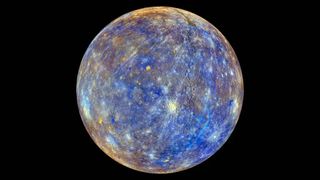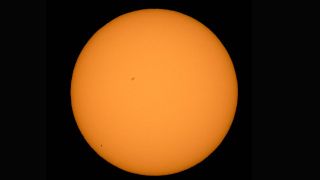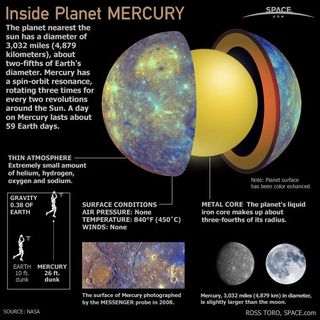Mercury: A complete guide to the closest planet to the sun
Mercury orbits the sun faster than all the other planets in the solar system.

Mercury is the closest planet to the sun and also the smallest planet in the solar system.
The small and cratered planet does not have any moons and zips around the sun faster than any other planet in the solar system, hence why the Romans named it after their swift-footed messenger god.
It is the second densest planet after Earth, with a huge metallic core roughly 2,200 to 2,400 miles (3,600 to 3,800 kilometers) wide, or about 75% of the planet's diameter. In comparison, Mercury's outer shell is only 300 to 400 miles (500 to 600 km) thick. The combination of its massive core and composition, which includes an abundance of volatile elements, has left scientists puzzled for years.
Related: 10 strange Mercury facts
The Sumerians also knew of Mercury at least 5,000 years ago. It was often associated with Nabu, the god of writing, according to a site connected to NASA's MESSENGER (Mercury Surface, Space Environment, Geochemistry and Ranging) mission.
Mercury was also given separate names for its appearance as both a morning star and an evening star. Greek astronomers knew, however, that the two names referred to the same body, and Heraclitus, around 500 B.C., correctly thought that both Mercury and Venus orbited the sun, not Earth.
How hot is Mercury?
Because the planet is so close to the sun, Mercury's surface temperature can reach a scorching 840 degrees Fahrenheit (450 degrees Celsius). However, since this world doesn't have much of a real atmosphere to entrap any heat, at night temperatures can plummet to minus 275 degrees Fahrenheit (minus degrees 170 Celsius), a temperature swing of more than 1,100 degrees Fahrenheit (600 degrees Celsius), the greatest in the solar system.
How big is Mercury?
Mercury is the smallest planet in the solar system — it is only slightly larger than Earth's moon. Since it has no significant atmosphere to stop impacts, the planet is pockmarked with craters. About 4 billion years ago, an asteroid roughly 60 miles (100 km) wide struck Mercury with an impact equal to 1 trillion 1-megaton bombs, creating a vast impact crater roughly 960 miles (1,550 km) wide. Known as the Caloris Basin, this crater could hold the entire state of Texas. Another large impact may have helped create the planet's odd spin, according to research in 2011.
Surface of Mercury
As close to the sun as Mercury is, in 2012, NASA's MESSENGER spacecraft discovered water ice in the craters around its north pole, where regions may be permanently shaded from the heat of the sun. The southern pole may also contain icy pockets, but MESSENGER's orbit did not allow scientists to probe the area. Comets or meteorites may have delivered ice there, or water vapor may have outgassed from the planet's interior and frozen out at the poles.

Average distance from the sun: 35,983,095 miles (57,909,175 km). By comparison: 0.38 Earth's distance from the sun
Perihelion (closest approach to sun): 28,580,000 miles (46,000,000 km). By comparison: 0.313 times that of Earth
Aphelion (farthest distance from sun): 43,380,000 miles (69,820,000 km). By comparison: 0.459 times that of Earth
Day length: 58.646 Earth days
Color: Gray
As if Mercury isn't small enough, it not only shrank in its past but is continuing to shrink today, according to a 2016 report. The tiny planet is made up of a single continental plate over a cooling iron core. As the core cools, it solidifies, reducing the planet's volume and causing it to shrink. The process crumpled the surface, creating lobe-shaped scarps or cliffs, some hundreds of miles long and soaring up to a mile high, as well as Mercury's "Great Valley," which at about 620 miles long, 250 miles wide and two miles deep (1,000 by 400 by 3.2 km) is larger than Arizona's famous Grand Canyon and deeper than the Great Rift Valley in East Africa.
"The young age of the small scarps means that Mercury joins Earth as a tectonically active planet with new faults likely forming today as Mercury's interior continues to cool and the planet contracts," Tom Watters, Smithsonian senior scientist at the National Air and Space Museum in Washington, D.C., said in a NASA statement.
Indeed, a 2016 study of cliffs on Mercury's surface suggested the planet may still rumble with earthquakes, or "Mercuryquakes." In addition, in the past, Mercury's surface was constantly reshaped by volcanic activity. However, another 2016 study suggested Mercury's volcano eruptions likely ended about 3.5 billion years ago.
One 2016 study suggested that Mercury's surface features can generally be divided into two groups — one consisting of older material that melted at higher pressures at the core-mantle boundary, and the other of newer material that formed closer to Mercury's surface. Another 2016 study found that the dark hue of Mercury's surface is due to carbon. This carbon wasn't deposited by impacting comets, as some researchers suspected — instead, it may be a remnant of the planet's primordial crust.
Mercury's magnetic field
A completely unexpected discovery made by Mariner 10 was that Mercury possessed a magnetic field. Planets theoretically generate magnetic fields only if they spin quickly and possess a molten core. But Mercury takes 59 days to rotate and is so small — just roughly one-third Earth's size — that its core should have cooled off long ago.
"We had figured out how the Earth works, and Mercury is another terrestrial, rocky planet with an iron core, so we thought it would work the same way," Christopher Russell, a professor at the University of California, Los Angeles, said in a University of California, Los Angeles statement.
An unusual interior could help to explain the differences in Mercury's magnetic field when compared to Earth. Observations from MESSENGER revealed that the planet's magnetic field is approximately three times stronger in its northern hemisphere than in its southern. Russell co-authored a model that suggests that Mercury's iron core may be turning from liquid to solid at the core's outer boundary rather than the inner.
"It's like a snow storm in which the snow formed at the top of the cloud and middle of the cloud and the bottom of the cloud too," said Russell. "Our study of Mercury's magnetic field indicates iron is snowing throughout this fluid that is powering Mercury's magnetic field."
The discovery in 2007 by Earth-based radar observations that Mercury's core may still be molten could help explain its magnetism, though the solar wind may play a role in dampening the planet's magnetic field.
Although Mercury's magnetic field is just 1% the strength of Earth's, it is very active. The magnetic field in the solar wind — the charged particles streaming off the sun — periodically touches upon Mercury's field, creating powerful magnetic tornadoes that channel the fast, hot plasma of the solar wind down to the planet's surface.
Does Mercury have an atmosphere?
Instead of a substantial atmosphere, Mercury possesses an ultra-thin "exosphere" made up of atoms blasted off its surface by solar radiation, the solar wind and micrometeoroid impacts. These quickly escape into space, forming a tail of particles, according to NASA.
The atmosphere of Mercury is a "surface-bound exosphere, essentially a vacuum." It contains 42% oxygen, 29% sodium, 22% hydrogen, 6% helium, 0.5% potassium, with possible trace amounts of argon, carbon dioxide, water, nitrogen, xenon, krypton and neon, according to NASA.
Mercury's orbit
Mercury speeds around the sun every 88 Earth days, traveling through space at nearly 112,000 mph (180,000 km/h), faster than any other planet. Its oval-shaped orbit is highly elliptical, taking Mercury as close as 29 million miles (47 million km) and as far as 43 million miles (70 million km) from the sun. If one could stand on Mercury when it is nearest to the sun, it would appear more than three times as large as it does when viewed from Earth.

Oddly, due to Mercury's highly elliptical orbit and the 59 Earth-days or so it takes to rotate on its axis, when on the scorching surface of the planet, the sun appears to rise briefly, set, and rise again before it travels westward across the sky. At sunset, the sun appears to set, rise again briefly, and then set again.
In 2016, a rare transit of Mercury happened, where the planet crossed the face of the sun as seen from Earth. Mercury's transit may have yielded secrets about its thin atmosphere, assisted in the hunt for worlds around other stars, and helped NASA hone some of its instruments.
As Mercury takes just Earth days to orbit the sun and Earth takes 365 days, approximately three or four times a year Mercury overtakes Earth during its trip around the sun and an optical illusion occurs, according to The New York Times. Mercury appears to move "backward" across the sky for about three weeks, it is during this time Mercury is said to be in retrograde. Astrologers consider Mercury in retrograde to be a time of misfortune and miscommunication as the perceived backward motion interferes with the planet's rules, according to Dictionary.com. The retrograde motion is explained in this YouTube video from Vox.
Mercury Q&A with an expert
We asked Larry Nittler, a cosmochemist who studies the origin and evolution of the solar system at Arizona State University, some questions about Mercury.

Larry Nittler is a cosmochemist at Arizona State University. He studies the origin and evolution of stars, the galaxy, and the solar system, both through laboratory analysis of extraterrestrial materials like meteorites and returned comet and asteroid samples and through planetary remote sensing via spacecraft.
What is a fun fact about Mercury?
Mercury is in what is called a 3:2 spin-orbit resonance with the sun. This means that it spins on its axis two times for every three times it goes around the sun. So a day on Mercury lasts 59 Earth days, while Mercury's year is 88 Earth days.
What temperature is planet Mercury?
Minus 292 degrees Fahrenheit (180 degrees Celsius) at night to 986 degrees Fahrenheit (530 degrees Celsius), the maximum during the day.
What color is the planet Mercury?
Very dark brownish grey.
Why isn't Mercury the hottest planet in the solar system?
Venus' very thick atmosphere traps so much heat by the greenhouse effect that it has the hottest surface despite being almost twice as far from the sun as Mercury.
What are some of the most fascinating aspects of this planet?
Although it is the smallest planet in the Solar System (excluding dwarf planets like Pluto), it has a surprisingly large Fe core, which makes it unusually dense and also has led to Mercury having a magnetic field like the Earth's (Venus and Mars do not have such fields).
Although it has a very weak atmosphere (known as an "exosphere"), this is too weak to trap heat so that the day side at 806 degrees Fahrenheit (430 degrees Celsius) is one of the hottest planetary surfaces in the solar system, and the night side one of the coldest at minus 292 degrees Fahrenheit (minus 180 degrees Celsius).
How does your work involve Mercury?
I was Deputy Principal Investigator on the MESSENGER mission to Mercury, for which I also led the analysis of data from the X-Ray Spectrometer instrument, used to map elemental abundances across the planet. I am currently a Co-I on a similar MIXS instrument onboard the BepiColombo mission which will reach Mercury in 2.5 years.
What surprising things about Mercury have we discovered recently?
We now know that there are deep impact craters near the poles where sunlight never reaches the bottom, and in many of these, there are large deposits of water ice, and organic matter. These may be the result of comets hitting the planet, and the water and organic molecules hopping across the surface until they find the coldest spots.
We have also learned that although Mercury's magnetic field is like the Earth's in that it is like a large bar magnet, on Mercury, the center of the field is not the center of the planet — it is offset from the equator by a few hundred kilometers. We don't know why.
We have also learned that the surface is rich in relatively volatile elements like sulfur and sodium, despite the planet getting so hot during the day. This helps rule out some ideas about how Mercury formed.
What mysteries remain about Mercury?
The biggest mystery is how it formed and why it has such a large iron core. There are a few very different ideas to explain this. One is that it formed much bigger than it is, and a giant impact stripped off most of the silicate mantle at some point early in its history. Another is that some process or processes concentrated metal relative to silicate in the inner part of the protoplanetary disk from which the solar system formed so Mercury's building blocks were naturally already enriched in iron. We need both better theoretical modeling of these ideas and more data to eventually work this out.
Mercury missions and research
The first spacecraft to visit Mercury was Mariner 10, which imaged about 45% of the surface and detected its magnetic field.
NASA's MESSENGER orbiter was the second spacecraft to visit Mercury. When it arrived in March 2011, it became the first spacecraft to orbit the planet. The mission came to an abrupt end on April 30, 2015, when the spacecraft, which had run out of fuel, purposely crashed onto the planet's surface for scientists to observe the results.
In 2012, scientists discovered a group of meteorites in Morocco that they think could have originated from the planet Mercury. If so, it would make the rocky planet a member of a very select club with samples available on Earth; only the moon, Mars and the large asteroid Vesta have verified rocks in human laboratories.
In 2016, scientists released the first-ever global digital-elevation model of Mercury, which combined more than 10,000 images acquired by MESSENGER to take viewers across the wide-open spaces of the tiny world. The model revealed the planet's highest and lowest points — the highest is found just south of Mercury's equator, sitting 2.78 miles (4.48 km) above the average elevation of the planet, while the lowest point resides in Rachmaninoff basin, the suspected home of some of the most recent volcanic activity on the planet, and lies 3.34 miles (5.38 km) below the landscape average.
In 2018, a new Mercury explorer was launched. The BepiColombo mission jointly operated by the European and Japanese space agencies is composed of two spacecraft — Mercury Planetary Orbiter and the Mercury Magnetospheric Orbiter — that, after a long trek to Mercury, will split up to better understand the tiny world. The European Space Agency's segment of the mission will focus on studying Mercury's surface while the Japan Aerospace Exploration Agency's portion will focus on the planet's strange magnetosphere.
In 2021, BepiColumbo captured its first views of Mercury during a gravity assist flyby. BepiColumbo is scheduled to arrive at Mercury in late 2025, and gather data during its one-year nominal mission with the possibility of a one-year extension, according to ESA.
Mercury images

A photomosaic of Mercury's southern hemisphere, made from images captured by NASA's Mariner 10 spacecraft.

Mercury is photographed passing across the sun in the lower third of the image. The planet appears as a small black dot.

An enhanced color composite image of the Caloris Basin on Mercury.

Image of Mercury captured by NASA's Mariner 10 spacecraft, the first probe to visit Mercury.

This colorful view of Mercury was produced by using images from the color base map imaging campaign during the primary mission of NASA's MESSENGER spacecraft.
Mercury quiz
Additional resources
Learn more about Mercury at NASA's Solar System Exploration website. Read about MESSENGER's top science results via Johns Hopkins Applied Physics Laboratory. See MESSENGER’s crater on Mercury, made when the spacecraft deliberately crashed into the planet
Bibliography
Strom, Robert G., and Ann L. Sprague. Exploring Mercury: the iron planet. New York: Springer, 2003.
Charlier, Bernard, and Olivier Namur. "The origin and differentiation of planet Mercury." Elements: An International Magazine of Mineralogy, Geochemistry, and Petrology 15.1 (2019): 9-14.
Mangano, Valeria, et al. "BepiColombo science investigations during cruise and flybys at the Earth, Venus and Mercury." Space Science Reviews 217.1 (2021): 1-81.
Hauck, Steven A., and Catherine L. Johnson. "Mercury: Inside the iron planet." Elements: An International Magazine of Mineralogy, Geochemistry, and Petrology 15.1 (2019): 21-26.
Join our Space Forums to keep talking space on the latest missions, night sky and more! And if you have a news tip, correction or comment, let us know at: community@space.com.
Get the Space.com Newsletter
Breaking space news, the latest updates on rocket launches, skywatching events and more!

Charles Q. Choi is a contributing writer for Space.com and Live Science. He covers all things human origins and astronomy as well as physics, animals and general science topics. Charles has a Master of Arts degree from the University of Missouri-Columbia, School of Journalism and a Bachelor of Arts degree from the University of South Florida. Charles has visited every continent on Earth, drinking rancid yak butter tea in Lhasa, snorkeling with sea lions in the Galapagos and even climbing an iceberg in Antarctica. Visit him at http://www.sciwriter.us
- Scott DutfieldContributor